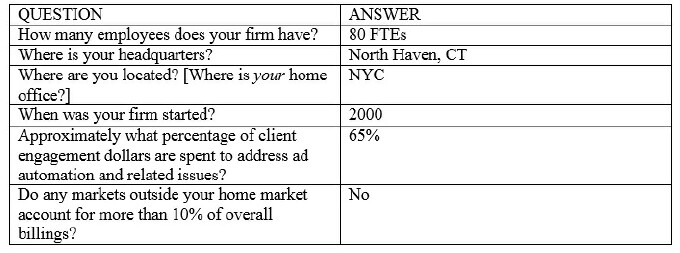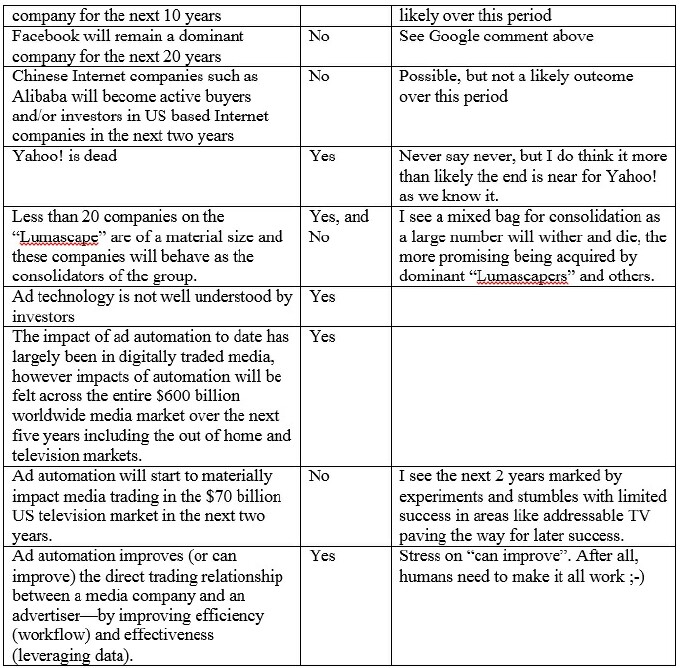

Posted on 2016-07-21 by Joe Lampert
In a series of conversations with the leading confidantes and consultants in the ad automation and programmatic area, Jay Sears, Senior Vice President Marketplace Development of Rubicon Project, discusses trends and issues of the day impacting advertisers and media owners. Here, Sears speaks with Joe Lampert, Executive Vice President Media Practice of Edge Technology Services. He has deep experience in backend agency and television systems with tenure at Harris Broadcast (now Imagine Communications), Mediaplex and Donovan Data Systems. [Editor's Note: Be sure to read the first three parts of this series: Jay's interviews with Joe Weaver of Promatica Consulting, Matt Prohaska of Prohaska Consulting and Matt Spiegel of MediaLink.]
JAY SEARS: What do you read to keep up with politics, art and culture?
JOE LAMPERT: Twitter, CNN.com, WSJ, MSN, Travel+Leisure, Wine Enthusiast, ESPN app (sports can cover art and culture, no?)
SEARS: What do you read to keep up with friends?
LAMPERT: Facebook, Instagram, e-mail and texts
SEARS: What do you read to keep up with the advertising technology industry?
LAMPERT: AdExchanger, Digiday, MediaPost, Broadcasting & Cable, The Drum, TV Technology, TVNewsCheck, Ad Age, AdWeek, Twitter and LinkedIn
SEARS: What’s your favorite commercial of all time?
LAMPERT: Alka Seltzer’s "Spicy Meatball" commercial. A classic that combines humor with high brand recall.
SEARS: With regards to advertising automation, what are the three biggest trends you expect to impact companies in 2016?
LAMPERT:
SEARS: With regards to advertising automation, what are the three most overblown topics that you wish would just go away?
LAMPERT:
SEARS: Describe your firm and then tell us the three most common issues you help clients on with respect to advertising automation and programmatic trading.
LAMPERT: Edge provides business and technology advisory consulting services to enable our clients to maximize their investments in infrastructure, revenue growth and people. Our principal consultants bring deep domain experience gained as senior industry practitioners across the ecosystem. Core practice areas include business management solutions, DAM/MAM, analytics and BI, and emerging programmatic solutions.

SEARS: What are the most common issues you help clients with regarding automation?
LAMPERT:
SEARS: The majority of ad technology companies (relatively small, unprofitable or both) have struggled. Of the poor performers, what are the commonalities between them that have contributed to this weakness?
LAMPERT: Often, those who struggle exhibit one or more of the following characteristics:
SEARS: A smaller handful of ad technology companies has achieved scale and performed better than the rest. What are the commonalities between them that have contributed to this relative strength?
LAMPERT: The leaders in this category tend to have the following characteristics in common:
SEARS: Do we live in a “tale of two cities” where Google and Facebook win almost everything, advertisers are dictated to and other media companies fight for the scraps?
LAMPERT: Digitally speaking (this is certainly not the case at all in traditional media), I find this premise to be a bit overblown. Having said that, Google and Facebook certainly do possess outsized clout as publishers compared to the competitive set.
SEARS: Please answer the following statements yes or no.


SEARS: If you could go to the airport right now with friends or family and fly anywhere in the world for vacation, who would you take and where would you go?
LAMPERT: A windjammer cruise of the Mediterranean with my immediate family.
SEARS: If you could create an endowment to fund any existing non-profit you designated, what lucky non-profit organization would that be?
LAMPERT: The Simon Wiesenthal Center. The Center confronts anti-Semitism, hate and terrorism, promotes human rights and dignity, and teaches the lessons of the Holocaust for future generations.
SEARS: What is your favorite restaurant in the world?
LAMPERT: Eleven Madison Park. A perfect combination of outstanding cuisine and service in a beautiful setting.
SEARS: Thanks, Joe!
Do you know a leading ad automation consultant in the automation and programmatic area advising advertisers and media companies that I should consider interviewing? Let me know.
The opinions and points of view expressed in this commentary are exclusively the views of the author and do not necessarily represent the views of MediaVillage.com/MyersBizNet management or associated bloggers.